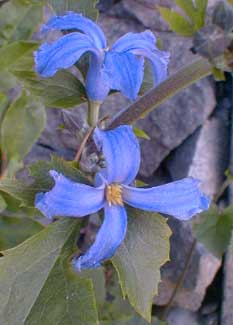
'Alblo' Alan Bloom Tube Clematis
or Shrub Clematis
"All gardeners live in beautiful places
because they make them so."
-Joseph Jouber
(1754-1824)
(1754-1824)
Initially named 'Bressingham Bluebird' by Alan Bloom of Blooms of Bressingham, the English nursery that introduced this variety of Clematis heracleifolia, it is today distributed under its first grower's name as 'Alan Bloom,' or contracted as 'Alblo,' having been renamed on the occasion of his 90th birthday.
A clumping shrubby clematis, it grows to about three feet by three feet. 'Alblo' is much closer to self-supporting as an upright shrub than is true of the sprawling species as a whole, but young specimens can sometimes be pretty floppy without some sort of supporting structure. After a couple of years it will usually be closer to self-supporting.
It is not a climber in any case. It should not be pruned its first year in the garden, but just before the following spring the whole shrub should be cut back to about six inches above the ground in order to start afresh; it blooms only from first-year wood.
Its curly intensely hyacinth-like blue tubular flowers occur on airy spikes that rise above the loose structure of foliage. The blooms are darker than on the light blue species, lending me to suppose it is developed from C. heracleifoilia var davidiana which is naturally dark blue. These spikes make good cut flowers.
The flowers are quite small. The July portrait shows close-ups of blooms much larger than life size. Although the blooms are not individually long-lasting, it has many buds opening serially beginning as early as June (definitely by July) with buds still opening late into September.
Fluffy seed-heads of this Chinese native are themselves hugely decorative & charming. Having such blossomy seeds makes thelong-flowering period seem longer still.
Autumn colors are only moderately interesting, turning yellow before leaf-fall.
It likes moist well-draining soil but is fairly drought-hardy after a couple years, once its considerable root system has gone deep & wide. The leaves want full sun. It will tolerate some shade & still bloom reasonably well, but will become leggy or sprawling if dissatisfied with its portion of sunlight.
The roots require some protection from the sun, so if a small groundcover can be started around its base, that should give it its needed protection, & it can shade its own base when mature.